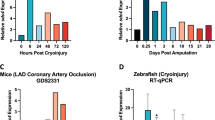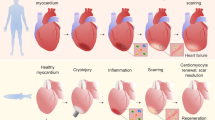Abstract
The discovery of the naturally occurring cardiac non-function (c) animal strain in Ambystoma mexicanum (axolotl) provides a valuable animal model to study cardiomyocyte differentiation. In homozygous mutant animals (c/c), rhythmic contractions of the embryonic heart are absent due to a lack of organized myofibrils. We have previously cloned a partial sequence of a peptide cDNA (N1) from an anterior-endoderm-conditioned-medium RNA library that had been shown to be able to rescue the mutant phenotype. In the current studies we have fully cloned the N1 full length cDNA sequence from the library. N1 protein has been detected in both adult heart and skeletal muscle but not in any other adult tissues. GFP-tagged expression of the N1 protein has revealed localization of the N1 protein in the endoplasmic reticulum (ER). Results from in situ hybridization experiments have confirmed the dramatic decrease of expression of N1 mRNA in mutant (c/c) embryos indicating that the N1 gene is involved in heart development.









Similar content being viewed by others
References
Hoffman JIE, Kaplan S (2002) The incidence of congenital heart disease. J Am Coll Cardiol 39:1890–1900
McKenna WJ (2008) Genetics of hypertrophic cardiomyopathy. In: UpToDate. Rose BD (ed) UpToDate, Waltham, MA
Kamisago M, Sharma DS, DePalma SR, Solomon S, Sharma P, McDonough B, Smoot L, Mullen MP, Woolf PK, Wigle ED, Seidman JG, Seidman CE (2000) Mutations in sarcomere protein genes as a cause of dilated cardiomyopathy. N Engl J Med 343:1688–1696
Humphrey RR (1972) Genetic and experimental studies on a mutant gene (c) determining absence of heart action in embrios of the Mexican Axolotl (Ambystoma mexicanum). Dev Biol 27:365–375
Lemanski LF (1973) Morphology of developing heart in cardiac lethal mutant Mexican Axolotls, Ambystoma Mexicanum. Dev Biol 33:312–333
LaFrance SM, Lemanski LF (1994) Imunofluorescent confocal analysis of tropomyosin in developing hearts of normal and cardiac mutant axolotls. Int J Devel Biol 38:695–700
Jacobson AG, Duncan JT (1968) Heart induction in salamanders. J Exp Zool 167:79–104
Jacobson AG, Sater AK (1988) Features of embryonic induction. Development 104:341–359
Lemanski LF, Paulson DJ, Hill CS (1979) Normal anterior endoderm corrects heart defect in cardiac mutant salamanders (Ambystoma Mexicanum). Science 204:860–862
Davis LA, Lemanski LF (1987) Induction of myofibrillogenesis in cardiac lethal mutant axolotl hearts rescued by RNA derived from normal endoderm. Development 99:145–154
Lemanski LF, Nakatsugawa M, Bhatia R, Erginel-Unaltuna N, Spinner BJ, Dube DK (1996) A specific synthetic RNA promotes cardiac myofibrillogenesis in the Mexican axolotl. Biochem Biophys Res Com 229:974–981
Erginel-Unaltuna N, Dube DK, Salsbury KG, Lemanski LF (1995) Confocal microscopy of a newly identified protein associated with heart development in the Mexican axoltl. Cell Mol Biol Re 41:117–130
Zhang C, Meng F, Huang XP, Zajdel R, Lemanski SL, Foster D, Erginel-Unaltuna N, Dube DK, Lemanski LF (2004) Downregulation of N1 gene expression inhibits the initial heartbeating and heart development in axolotls. Tissue Cell 36:71–81
Zajdel RW, McLean MD, Lemanski SL, Muthuchamy M, Wieczorek DF, Lemanski LF, Dube DK (1998) Ectopic expression of tropomyosin promotes myofibrillogenesis in mutant axolotl hearts. Dev Dyn 213:412–420
Duvernay MT, Zhou F, Wu G (2004) Conserved motif for the transport of G protein-coupled receptors from the endoplasmic reticulum to the cell surface. J Biol Chem 279:30741–30750
Zhang C, Dube DK, Huang X, Zajdel RW, Bhatia R, Foster D, Lemanski SL, Lemanski LF (2003) A point mutation in bioactive RNA results in the failure of mutant heart correction in Mexican axolotls. Anat Embryol 206:495–506
Srivastava D, Olson EN (2000) A genetic blueprint for cardiac development. Nature 407:221–226
Olson EN (2006) Gene regulatory networks in the evolution and development of the heart. Science 313:1922–1927
LaFrance SM, Fransen ME, Erginel-Unaltuna N, Dube DK, Robertson DR, Stefanu C, Ray TK, Lemanski LF (1993) RNA from normal anterior endoderm/mesoderm-conditioned medium stimulates myofibrillogenesis in developing mutant axolotl hearts. Cell Mol Biol Res 39:547–560
Munro S, Pelham HR (1987) C-terminal signal prevents secretion of luminal ER proteins. Cell 48:899–907
Jackson MR, Nilsson T, Peterson PA (1990) Identification of a consensus motif for retention of transmembrane proteins in the endoplasmic reticulum. EMBO J 9:3153–3162
Zerangue N, Schwappach B, Jan YN, Jan LY (1999) A new ER trafficking signal regulates the subunit stoichiometry of plasma membrane K(ATP) channels. Neuron 22:537–548
Xie R, Clark KM, Gorovsky MA (2007) Endoplasmic reticulum retention signal-dependent glycylation of the Hsp70/Grp170-related Pgp1p in Tetrahymena. Eukaryot Cell 6:388–397
Sobkow L, Epperlein HH, Herklotz S, Straube WL, Tanaka EM (2006) A germline GFP transgenic axolotl and its use to track cell fate: dual origin of the fin mesenchyme during development and the fate of blood cells during regeneration. Dev Biol 290:386–397
Putta S, Smith JJ, Walker JA, Rondet M, Weisrock DW, Monaghan J, Samuels AK, Kump K, King DC, Maness NJ, Habermann B, Tanaka E, Bryant SV, Gardiner DM, Parichy DM, Voss SR (2004) From biomedicine to natural history research: EST resources for ambystomatid salamanders. BMC Genomics 5:54
Smith JJ, Putta S, Walker JA, Kump DK, Samuels AK, Monaghan JR, Weisrock DW, Staben C, Voss SR (2005) Sal-site: integrating new and existing ambystomatid salamander research and informational resources. BMC Genomics 6:181
Acknowledgements
This study was supported by NIH grants HL061246 and HL58435 and by a Christine E. Lynn American Heart Association Grant-in-Aid to L.F.L. Some of the embryos used for this study were provided by the Axolotl Colony at University of Kentucky (NSF-DBI–0443496).
Author information
Authors and Affiliations
Corresponding author
Rights and permissions
About this article
Cite this article
Jia, P., Zhang, C., Huang, X.P. et al. A novel protein involved in heart development in Ambystoma mexicanum is localized in endoplasmic reticulum. J Biomed Sci 15, 789–799 (2008). https://doi.org/10.1007/s11373-008-9262-y
Received:
Accepted:
Published:
Issue Date:
DOI: https://doi.org/10.1007/s11373-008-9262-y




